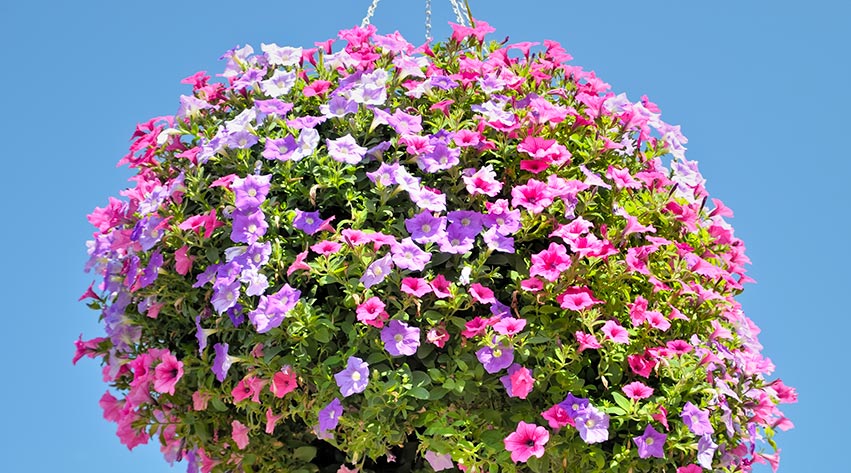Your hanging basket will thrive in a sunny location but if this isn’t possible, or you’re trying to brighten up a typically dull spot in your garden, there are plants that will do well in a shady position. Because hanging baskets are a little vulnerable, try to place yours in a sheltered spot, this will reduce the amount of watering required as well as protecting your basket from the wind.

How to plant a hanging basket
Hanging baskets and hanging pots are an instant way to beautify your house, fences or trellis, giving your garden more personality and character. During the summer, hanging baskets can really lighten up even the dullest porch or doorway, making a wonderful first impression for visitors to your home. From seasonal bedding plants and dwarf bulbs to herbs to low growing evergreens that can be used for a permanent display, hanging baskets are suitable for a great range of plants adding height and interest to even the cosiest of outdoor spaces.
Choosing a location for your hanging basket
Types of hanging basket
There are many varieties available and which basket you choose really depends on the effect you would like to achieve and the space you have to work with.
Generally speaking, hanging baskets fall under two main types; Hanging Pots and Wire Baskets. Hanging pots can only be planted in the top whereas wire baskets can be planted in the sides as well as the top, for a fuller effect.
Hanging pots
These are usually made from plastic and planted in the top, although some may have planting holes in the sides. They may or may not come with a detachable saucer that will help cut down on watering. Some have a built in ‘self-watering’ system.
Wire baskets
These are the more traditional baskets that need to be lined before they are planted up. These baskets can have plants put into the sides and base of them to create a beautiful fully-rounded basket of blooms.
These are the main types of liners you can use for wire baskets:
- Sphagnum moss – Sphagnum moss can be very effective; it retains water well, feels nice and looks great.
- Cocoa liners – Typically, cocoa liners are normally bought as a pre-moulded structure to fit certain baskets. They’re thick, so they’re less suitable if you want to plant towards the sides of the basket.
- Hessian – One of the most popular liners due to its low price and flexibility. It’s also very environmentally friendly, making it a great choice for the organically minded gardener.
- Supamoss – An incredibly versatile liner for hanging baskets, Supamoss is filled with drainage holes, but can still retain enough water for plants due to its thick plastic coating.
Which plants to choose for the time of year
As with almost any form of gardening, hanging baskets will work best with different plants at different times of the year. If you’re looking for inspiration, we recommend the following;
Spring (February-May)
Pansies are always really popular in the spring as they’re tough enough to withstand pretty much anything – they can take the April showers! Of course, they also look lovely and come in enough varieties to suit practically any colour scheme. These can be added to with Tete-a-Tete (mini Daffodils), Primroses or Bellis.
Summer (June-September)
One of the keys to a good looking summer basket is variation, so we recommend mixing styles up at this time of year. Fuchsias, Begonias and Geraniums are great choices during the summer. Fuchsias will take more shade, whilst Geraniums love a sunbaked place. If you don’t want to mix styles up, we definitely recommend Petunias – they grow fast!
Autumn & winter (September – March)
Deep purples, whites, reds and blues are all very autumnal colours, which makes Viola a fantastic choice for the autumn basket. If you wish to add a stylish backdrop, then Cineraria Silver Dust plants are a great choice. Small, hardy plants such as Heathers, Heucheras, Skimmia and grasses will add structure for up to eight months.
Autumn/winter baskets can be planted in the same way as summer baskets, but the addition of water retaining gel is not necessary. Adding this to winter baskets can result in waterlogged compost during wet weather. Dwarf spring bulbs such as Daffodils and Crocus can be added to winter and spring baskets for extra interest.
How to prepare your hanging basket
Once you’ve chosen which container is right for you, start work on making it an excellent environment for plant growth. There are a couple of main things to bear in mind here:
Firstly, ensure that water can drain adequately. If the water has nowhere to go, the soil will become waterlogged, and this isn’t good for the plants! Plastic containers will usually have drainage holes, but if you’ve got a wicker basket with a plastic liner, you’ll often need to punch your own holes in it.
Plastic tubs will typically have drainage holes pre-drilled. Just in case though, try and put crocs (a layer of gravel or broken pottery) in to stop compost blocking the drainage holes.
What you will need
- Basket and liner if required
- A large pot to support the basket while you are planting it, if the base is not flat
- Compost, slow release fertiliser and ‘swell gel’ (water retaining crystals)
- Suitable plants (see below)
- Gloves
- Scissors to cut the liner if you are using a rigid one and wish to plant the sides of the basket
How to plant up a hanging basket
Thoroughly mix the compost with the correct amount of slow release fertiliser and water retaining crystals. Also mix in some water if the compost is dry. Water the plants beforehand and allow them to drain.
Wire baskets that need to be lined
- Balance the basket in a large pot and line half way up with a thick layer of moss or other loose liner. Add enough compost to cover the base of the basket.
- ‘Plant’ three or four trailing plants in the sides of the basket, by pushing them through the wire. Make sure that the lining material fits snugly around the base of the plant to prevent the compost falling out until the plants have established.
- Add more compost, gently pushing it down around the roots of the plants.
- Continue to add layers of plants, liner and compost. Two layers of plants evenly spaced around the sides of the basket are usually sufficient.
- Make sure that there is enough liner around the base of the plants and that there are no holes in it so that the compost escapes.
- Once the sides of the basket are planted, add more liner and plant up the top.
- Gently push the plants into the top of the basket, working them in between the root balls of the plants that are in the sides. The basket may be quite congested by now, so add compost as you need it around the roots.
- Make sure that there are no roots showing on the surface of the compost.
- Water the basket well and leave it in a cold greenhouse or sheltered spot to establish for a few days before hanging it up.
Baskets with no liners
- Fill the pot with compost and plant the top.
- Trailing plants that are used around the sides should be angled towards the edge of the pot.
- Once you have planted the pot, water it well and leave it in a cold greenhouse or sheltered spot to establish for a few days before hanging it up.
Top Tips
- Check your basket twice each day for water, especially if it is in a sunny spot. Make sure it feels heavy after it has been watered
- Although slow release fertiliser has been added to the compost, your basket will benefit from a suitable liquid feed added to the water once a week, when the plants are established
- Remove spent flower heads regularly to encourage more flowers through the season
- When the top of the soil is dry to the touch, this is a good indication that the basket needs re-watering
- The whole basket is sufficiently watered if water is starting to come through the drainage holes. Water slowly to allow the compost to soak into the core
Permanently planted baskets
These should be treated like any other plants grown in a container. Liquid feed should be used once a week through the growing season and they should be regularly watered. If the plants are outgrowing their container, remove some of the roots and re-pot in fresh compost and slow release fertiliser.


